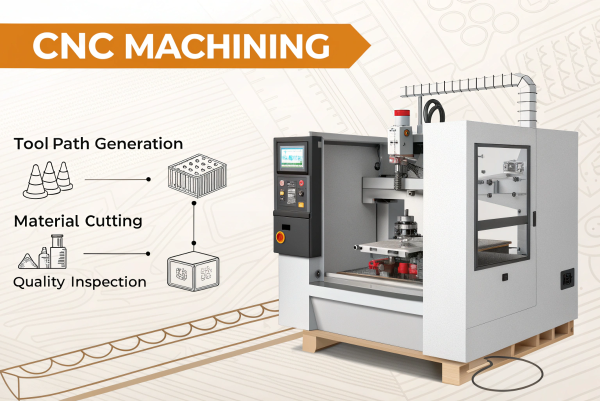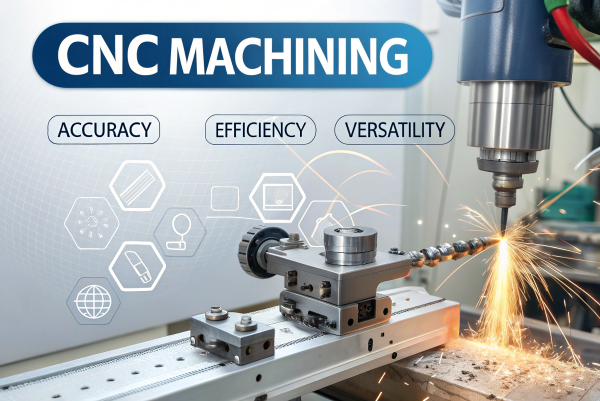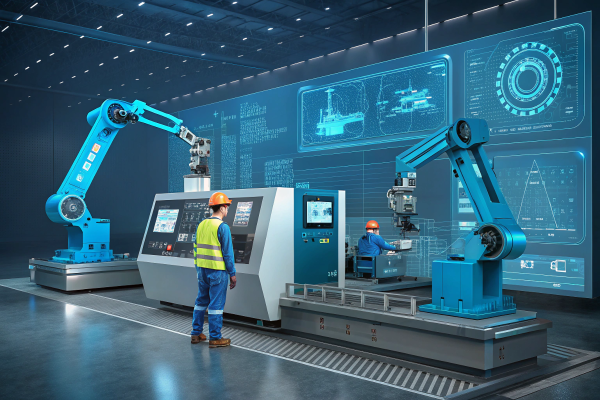CNC machining—let’s be real—sounds like one of those technical terms that could easily make your head spin. But once you break it down, it’s actually pretty simple and cool. CNC stands for Computer Numerical Control, and it’s basically a way of telling machines exactly what to do, like using a super precise recipe for making parts. You feed the machine the design, and it takes care of the rest. It’s like the machine has its own brain, running off of a computer program.

CNC machining is a high-precision manufacturing process. Computer-controlled machines perform operations like milling, turning, and drilling on a workpiece. It transforms raw materials into precise components. This ensures minimal human error and maximum repeatability. It is crucial for industries requiring tight tolerances and consistent quality.
Now, you might be thinking, “Okay, cool, but what does that actually mean in the real world?” Let’s dive into that.
How Does CNC Machining Work?
Okay, imagine you have a block of metal (or any material really—plastic, wood, you name it). Now, you want to carve it into something super precise—a part for a car, an aircraft component, or even something for a medical device. That’s where CNC machining comes in.
With CNC machining, you can take your design (which is usually created on a computer using CAD software) and send it to a CNC machine. The machine then reads the design and starts cutting, shaping, or drilling away at the material, layer by layer, until it’s just right. And the beauty of it? Precision. Seriously, these machines can be so accurate that the tiniest adjustments make a huge difference. Think of it like carving a sculpture, but instead of a chisel and hammer, you're using tools controlled by a computer.

Why Is CNC Machining So Important?
I think the real magic of CNC machining is how it combines technology and craftsmanship. Machines can make parts much faster than by hand, but with that same level of intricate detail. And that’s why it’s become such a game-changer in industries like aerospace, automotive, and medical devices. It allows for complex designs, faster production, and more precise manufacturing.
Here’s the thing: without CNC machining, some of the designs we take for granted—like the parts in your car engine or the components in your phone—wouldn’t be possible, or at least not to the level of perfection that we expect.
It’s also kind of amazing when you think about it: a company that’s got, let’s say, a small CNC machine can now create parts that are used in everything from spaceships to surgical instruments. That level of accessibility and precision has truly changed the landscape of manufacturing.

CNC Machining Applications
CNC machining is used across a variety of industries due to its versatility and precision. Below is a breakdown of key sectors where CNC technology plays a critical role:
| Industry | Application Description | Example |
|---|---|---|
| Aerospace | In aerospace, CNC machining helps shape some of the most demanding and intricate parts, often working with specialized materials like titanium. These components need to be incredibly strong, lightweight, and able to withstand extreme conditions. | CNC-machined parts for jet engines, which must handle extreme temperatures and high-speed rotations. |
| Automotive | CNC machines in the automotive world create everything from engine parts to custom performance components. Precision and reliability are key, especially when dealing with the high stresses and strains that car parts must endure. | Custom turbocharger components that boost car engine performance, or intricate parts for electric vehicle batteries. |
| Medical Devices | In the medical field, CNC machining is essential for creating highly specialized parts, often with complex geometries that need to fit perfectly. These parts are usually customized for individual patients, ensuring they fit exactly where needed. | CNC-machined titanium implants for joint replacements or prosthetic limbs tailored to fit a patient’s exact specifications. |
| Electronics | CNC machining allows for the creation of tiny, precise components used in electronics. Whether it's a casing for a smartphone or an intricate connector inside a device, these components need to be produced with extremely tight tolerances. | CNC-machined connectors for high-performance computer circuits or smartphone enclosures. |
| Furniture Design | CNC machines bring precision to furniture-making, allowing for the creation of highly detailed and intricate designs that can be replicated consistently. Whether working with wood or synthetic materials, CNC helps achieve perfect symmetry and finish. | Custom-designed wooden tables with intricate carvings, or minimalist modern furniture made from composite materials. |
| Energy | CNC machining is critical in energy sectors, particularly for creating components that must operate under extreme conditions, such as turbine blades or pressure valves. These parts need to be perfectly balanced and withstand high levels of stress. | CNC-machined blades for wind turbines that need to be both lightweight and durable in harsh environments. |

The Future of CNC Machining
As we look toward the future, CNC machining is bound to evolve, and the possibilities are as wide as they are exciting. Today, we’re already seeing the emergence of smart CNC machines—machines that use advanced sensors and real-time data analytics to adapt and optimize their operations on the fly. Imagine a CNC machine that can detect slight changes in material properties or tool wear and then adjust its settings automatically. This makes the entire process more efficient, reduces errors, and ultimately leads to cost savings. It’s like having a self-aware machine that knows exactly how to produce the perfect part, no matter the conditions.
But let’s not stop there—there’s also the growing influence of additive manufacturing, or 3D printing, which, when combined with CNC machining, could open up new frontiers for creating hybrid components. Imagine a part being 3D printed for its core structure and then CNC machined for its precise surface finish—this would allow for incredible flexibility in design and production.
Another exciting trend is the increasing use of materials science to push CNC machining beyond traditional metals and plastics. New materials like graphene, biodegradable plastics, and advanced composites are slowly making their way into the manufacturing world, and CNC machines will need to adapt to process these tougher, more complex materials.
But here's the kicker—while the technology continues to advance, one thing will always remain the same: the human touch. No machine, no matter how advanced, can replace the creativity, innovation, and intuition that comes from human expertise. It's the engineers, designers, and machinists who push the boundaries of what CNC machining can achieve. They’re the ones who’ll help transform these emerging technologies into the next generation of manufacturing.

Final Thoughts: Why CNC Machining Matters
In the grand scheme of things, CNC machining might seem like just another technical process—something that happens in factories or behind closed doors. But in reality, it's at the very heart of modern manufacturing. CNC machining enables everything we use in our daily lives: from the sleek, lightweight frames of our smartphones to the high-performance parts that power our vehicles, and even the life-saving devices used in hospitals.
So why does CNC machining matter? It’s simple. It empowers us to build better, faster, and more precisely than ever before. It brings impossible designs to life and makes the impossible possible. It takes materials that are tough and unwieldy and transforms them into finely crafted components. It’s the backbone of industries that are shaping the future, whether that’s the aerospace industry flying us to new heights, or the medical industry saving lives with cutting-edge devices.

And as we continue to innovate, it’s exciting to think about the new possibilities that CNC machining will unlock. We’re talking about the next generation of smart machines, smarter materials, and faster, more efficient manufacturing processes. The future of CNC machining is bright, and it’s only going to get more fascinating as we push the limits of what’s possible.
So, the next time you see a finely crafted part, whether it’s something in your car, your phone, or even something more complex like a medical implant, just know—there’s probably a CNC machine behind it, working its magic. And that, my friend, is why CNC machining matters.
FAQ:
-
What is a CNC machine application?
CNC machine applications refer to the use of computer-controlled machines for manufacturing parts and components with high precision. These machines are employed in various industries, such as automotive, aerospace, and medical, to produce complex and accurate parts. -
What do you mean by CNC machining?
CNC machining is a process that uses computer numerical control (CNC) systems to control machine tools, like lathes, mills, and routers, to remove material from a workpiece. This method allows for high-precision and repeatable manufacturing of parts. -
What is the application of machining?
Machining applications involve shaping and cutting materials, often metals, into precise and detailed components used in manufacturing. It is essential in industries such as automotive, aerospace, and electronics for producing parts that require high accuracy. -
What are the applications of computer numerical control?
The applications of CNC include the production of complex and precise parts in industries like automotive, aerospace, and medical device manufacturing. CNC technology improves efficiency, accuracy, and repeatability in various machining operations. -
What is the main use of CNC machine?
The main use of a CNC machine is to automate the manufacturing of


